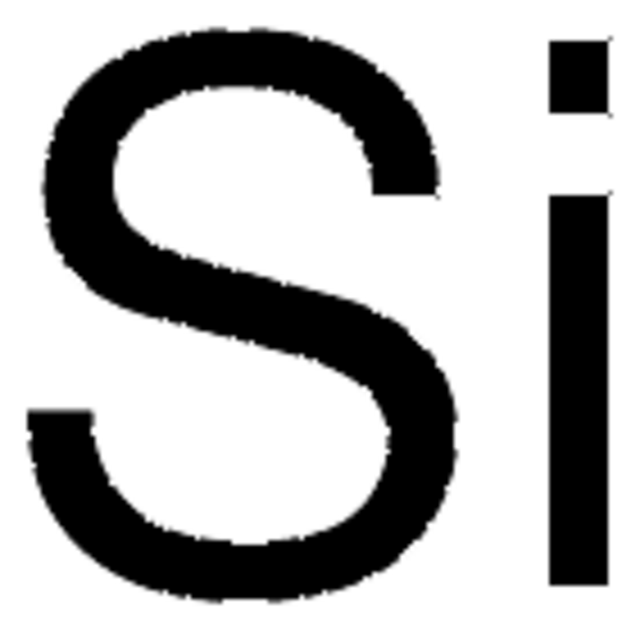637246
Siliciumdioxid
nanopowder (spherical, porous), 5-20 nm particle size (TEM), 99.5% trace metals basis
Synonym(e):
Silicium(IV)-oxid, Siliziumdioxid
About This Item
Qualitätsniveau
Assay
99.5% trace metals basis
Form
nanopowder (spherical, porous)
Oberflächenbereich
590-690 m2/g , TEM
Partikelgröße
5-20 nm (TEM)
bp
2230 °C (lit.)
mp (Schmelzpunkt)
>1600 °C (lit.)
Dichte
2.2-2.6 g/mL at 25 °C
Schüttdichte
0.068 g/mL
SMILES String
O=[Si]=O
InChI
1S/O2Si/c1-3-2
InChIKey
VYPSYNLAJGMNEJ-UHFFFAOYSA-N
Suchen Sie nach ähnlichen Produkten? Aufrufen Leitfaden zum Produktvergleich
Verwandte Kategorien
Allgemeine Beschreibung
Anwendung
- Pickering emulsion polymerization using a silicon dioxide nanoparticle stabilizer to form molecularly imprinted polymers for steroid recognition.
- Mesoporous silica is used as a catalyst support in the preparation of multiwalled carbon nanotubes (MWCNTs).
- It is used as a ring opening of tetrahydrofuran-dimethanol to 1,2,6-hexanetriol.
- It maybe used to prepare silica/brominated poly(phenylene oxide) nanocomposites membranes for CO2 seperations.
- The composite scaffold of chitosan/chondroitin sulfate/nano-SiO2 was fabricated by lyophilization.
- Nanocomposites preparation of silica, single-wall carbon nanotubes, and graphite nanoplatelets in an epoxy matrix have been reported.6
- Dielectric spectroscopy study of the polystyrene/nanosilica model system has been studied.
- PMMA SiO2 nanocomposites were reported to be synthesized.
Lagerklassenschlüssel
11 - Combustible Solids
WGK
nwg
Flammpunkt (°F)
Not applicable
Flammpunkt (°C)
Not applicable
Persönliche Schutzausrüstung
dust mask type N95 (US), Eyeshields, Gloves
Analysenzertifikate (COA)
Suchen Sie nach Analysenzertifikate (COA), indem Sie die Lot-/Chargennummer des Produkts eingeben. Lot- und Chargennummern sind auf dem Produktetikett hinter den Wörtern ‘Lot’ oder ‘Batch’ (Lot oder Charge) zu finden.
Besitzen Sie dieses Produkt bereits?
In der Dokumentenbibliothek finden Sie die Dokumentation zu den Produkten, die Sie kürzlich erworben haben.
Kunden haben sich ebenfalls angesehen
Artikel
Self-Assembled Nanodielectrics (SANDs) for Unconventional Electronics
Hydrogen is one of the most important resources in providing food, fuel, and chemical products for our everyday life. Sustainable catalytic hydrogen production from bioethanol has gained significant attention in recent years due to globally diminishing fossil fuel supplies, which have necessitated the search for new chemical feedstocks.
Recent demand for electric and hybrid vehicles, coupled with a reduction in prices, has caused lithium-ion batteries (LIBs) to become an increasingly popular form of rechargeable battery technology.
Silica is a very popular inorganic nanomaterial used in a wide range of applications including fillers for rubber, catalyst supports, separation media, carriers in food and agriculture, and abrasive/anticaking agents in cosmetics. It is also widely believed to be an important material for biomedical applications for following reasons.
Unser Team von Wissenschaftlern verfügt über Erfahrung in allen Forschungsbereichen einschließlich Life Science, Materialwissenschaften, chemischer Synthese, Chromatographie, Analytik und vielen mehr..
Setzen Sie sich mit dem technischen Dienst in Verbindung.

